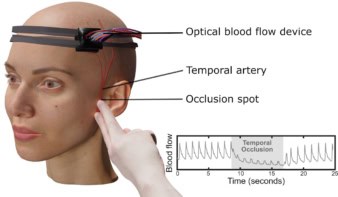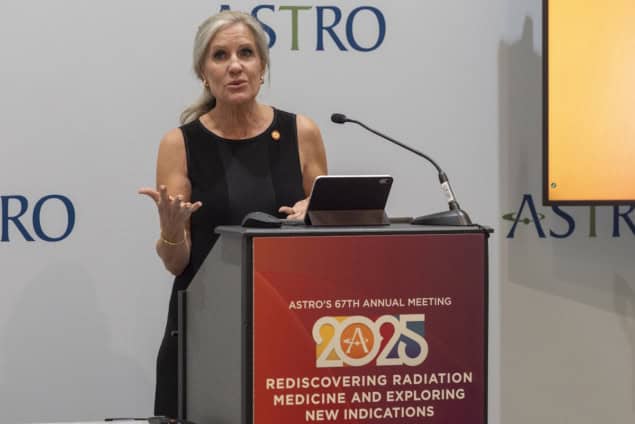
“ASTRO 2025 has opened with a palpable sense of momentum. The turnout has been really strong and the energy is unmistakable,” said Catheryn Yashar, president-elect of the American Society for Radiation Oncology (ASTRO). “There’s a buzz in the exhibit hall, lots of talking in the lobby. And the sessions have generated excitement – it’s data that’s challenging our long held standards and testing the expanding rules of radiation therapy.”
Yashar was speaking at a news briefing arranged to highlight a select few high-impact abstracts. And in accord with the ASTRO 2025 meeting’s theme of “rediscovering radiation medicine and exploring new indications”, the chosen presentations included examples of innovative techniques and less common indications, including radiotherapy treatments of non-malignant disease and a novel combination of external-beam radiation with radioligand therapy.
Keeping heart rhythm under control
Ventricular tachycardia (VT) is a life-threatening heart rhythm disorder that’s usually treated with medication, implantation of a cardiac device and then catheter ablation, an invasive procedure in which a long catheter is inserted via a leg vein into the heart to destroy abnormal cardiac tissue. A research team at Washington University School of Medicine has now shown that stereotactic arrhythmia radiation therapy (STAR) could provide an equally effective and potentially safer treatment alternative.
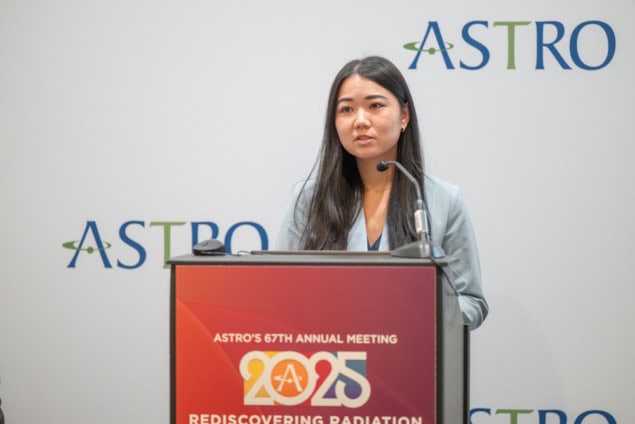
STAR works by delivering precision beams of radiation to the scarred tissue that drives the abnormal heart rhythm, without requiring invasive catheters or anaesthesia.
“Over the past several years, STAR has emerged as a novel non-invasive treatment for patients with refractory VT,” said Shannon Jiang, who presented the team’s findings at ASTRO. “So far, there have been several single-arm studies showing promising results for STAR, but there are currently no data that directly compare STAR to catheter ablation, and that’s the goal for our study.”
Jiang and colleagues retrospectively analysed data from 43 patients with recurrent refractory VT (which no longer responds to treatment). Patients were treated with either STAR or repeat catheter ablation at a single institution. The team found that both treatments were similarly effective at controlling arrhythmia, but patients receiving radiation had far fewer serious side effects.
Within one year of the procedure, eight patients (38%) in the ablation group experienced treatment-related serious adverse events, compared with just two (9%) in the STAR group. These complications occurred sooner after ablation (median six days) than after radiation (10 months). In four cases, patients receiving ablation died within a month of treatment, soon after experiencing an adverse event, and one patient did not survive the procedure. In contrast, in the STAR group, there were no deaths attributed to treatment-related side effects. One year after treatment, overall survival was 73% following radiation and 58% after ablation; at three years (the median follow-up time), it was 45% in both groups.
“Despite the fact that this is a retrospective, non-randomized analysis, our study provides some important preliminary data that support the use of STAR as a potentially safer and equally effective treatment option for patients with high-risk refractory VT,” Jiang concluded.
Commenting on the study, Kenneth Rosenzweig from Icahn School of Medicine at Mount Sinai emphasizes that the vast majority of patients with VT will be well cared for by standard cardiac ablation, but that radiation can help in certain situations. “This study shows that for patients where the ablation just isn’t working anymore, there’s another option. Some patients will really need the help of radiation medicine to get them through, and work like this will help us figure out who those patients are and what we can do to improve their quality-of-life.”
A radiation combination
A clinical trial headed up at the University of California, Los Angeles, has shown that adding radioligand therapy to metastasis-directed radiation therapy more than doubles progression-free survival in men with oligometastatic prostate cancer, without increasing toxicity.
“When we pair external-beam radiation directed to tumours we can see with a radiopharmaceutical to reach microscopic disease we can’t see, patients can experience a notably longer interval before progression,” explained principal investigator Amar Kishan.
Patients with oligometastatic prostate cancer (up to five metastases outside the prostate after initial therapy) are increasingly treated with metastasis-directed stereotactic body radiation therapy (SBRT). While this treatment can delay progression and the need for hormone therapy, in most patients the cancer recurs, likely due to the presence of undetectable microscopic disease.
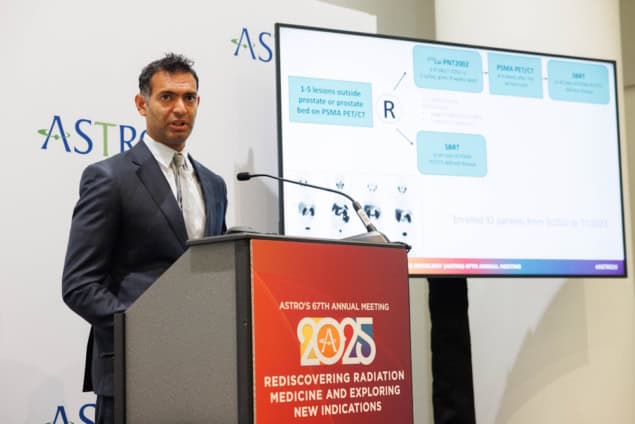
Radioligand therapy uses a radiopharmaceutical drug to deliver precise radiation doses directly to tumours. For prostate cancer, the drug combines radioactive isotope lutetium-177 with a ligand that targets the prostate-specific membrane antigen (PSMA) found on cancer cells. Following its promising use in men with advanced prostate cancer, the team examined whether adding radioligand therapy to SBRT could also improve progression-free survival in men with early metastatic disease.
The phase II LUNAR trial included 92 men with oligometastatic prostate cancer and one to five distant lesions as seen on a PSMA PET/CT scan. The patients were randomized to receive either SBRT alone (control arm) or two cycles of the investigational PSMA-targeting drug 177Lu-PNT2002, eight weeks apart, followed by SBRT.
At a median follow-up of 22 months, adding radioligand therapy improved median progression-free survival from 7.4 to 17.3 months. Hormone therapy was also delayed, from 14.1 months in the control group to 24.3 months. Of 65 progression events observed, 64 were due to new lesions rather than regrowth at previously treated sites. Both treatments were well tolerated, with no difference in severe side effects between the two groups.
“We conclude that adding two cycles of 177Lu-PNT2002 to SBRT significantly improves progression-free survival in men with oligorecurrent prostate cancer, presumably by action on occult metastatic disease, without an increase in toxicity,” said Kishan. “Ultimately, while this intervention worked well, 64% of patients even on the investigational arm still had some progression, so we could further optimize the dose and cycle and other variables for these patients.”
Pain relief for knee osteoarthritis
Osteoarthritis is a painful joint disease that arises when the cartilage cushioning the ends of bones wears down. Treatments include pain medication, which can cause significant side effects with long-term use, or invasive joint replacement surgery. Byoung Hyuck Kim from Seoul National University College of Medicine described how low-dose radiotherapy (LDRT) could help bridge this treatment gap.
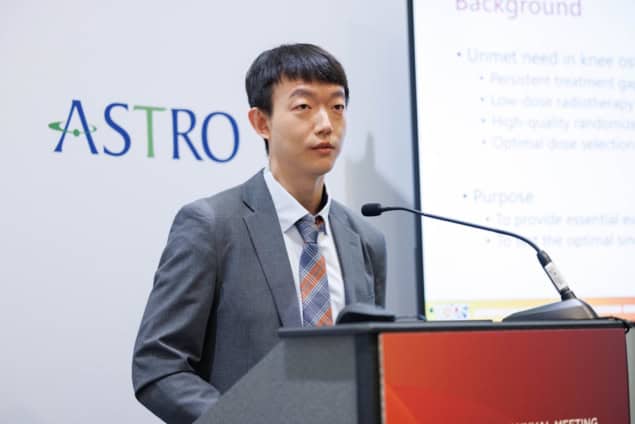
LDRT could provide a non-invasive alternative treatment for knee osteoarthritis, a leading cause of disability, Kim explained. But while it is commonly employed in Europe to treat joint pain, its use in other countries is limited by low awareness and a lack of high-quality randomized evidence. To address this shortfall, Kim and colleagues performed a randomized, placebo-controlled trial designed to provide sufficient evidence to incorporate LDRT into clinical standard-of-care.
“There’s a clinical need for moderate interventions between weak pain medications and aggressive surgery, and we think radiation may be a suitable option for those patients, especially when drugs and injections are poorly tolerated,” said Kim.
The multicentre trial included 114 patients with mild to moderate knee osteoarthritis. Participants were randomized to receive one of three treatments: 0.3 Gy radiotherapy in six fractions; 3 Gy in six fractions; or sham irradiation where the treatment system did not deliver radiation – an approach that had not been tested in previous studies.
The use of pain medication was limited, to avoid masking effects from the radiation itself. Response was considered positive if the patients (who did not know which treatment they had received) exhibited improvements in pain levels, physical function and overall condition.
“Interestingly, at one month [after treatment], the response rates were very similar across all groups, which reflects a strong placebo effect from the sham group,” said Kim. “At four months, after the placebo effect had diminished, the 3 Gy group demonstrated significantly higher response rate compared to the sham control group; however, the 0.3 Gy group did not.”

Leo Cancer Care launches first upright photon therapy system
The response rates at four months were 70.3%, 58.3% and 41.7%, for the 3 Gy, 0.3 Gy and sham groups, respectively. As expected, with radiation doses less than 5% of those typically used for cancer treatments, no radiation-related side effects were observed.
“Our study shows that a single course of low-dose radiotherapy improves knee osteoarthritis symptoms and function at four months, with no treatment-related toxicity observed,” Kim concluded. “So our trial could provide objective evidence and suggest that LDRT is a non-pharmacologic scalable option that merits further trials.”
“While small, [the study] was really well executed in terms of being placebo controlled. It clearly showed that the 3 Gy arm was superior to the placebo control arm and there was a 30% benefit,” commented Kristina Mirabeau-Beale from GenesisCare. “So I think we can say definitively that the benefit is from radiation more than just the placebo effect of interacting with our healthcare system.”


